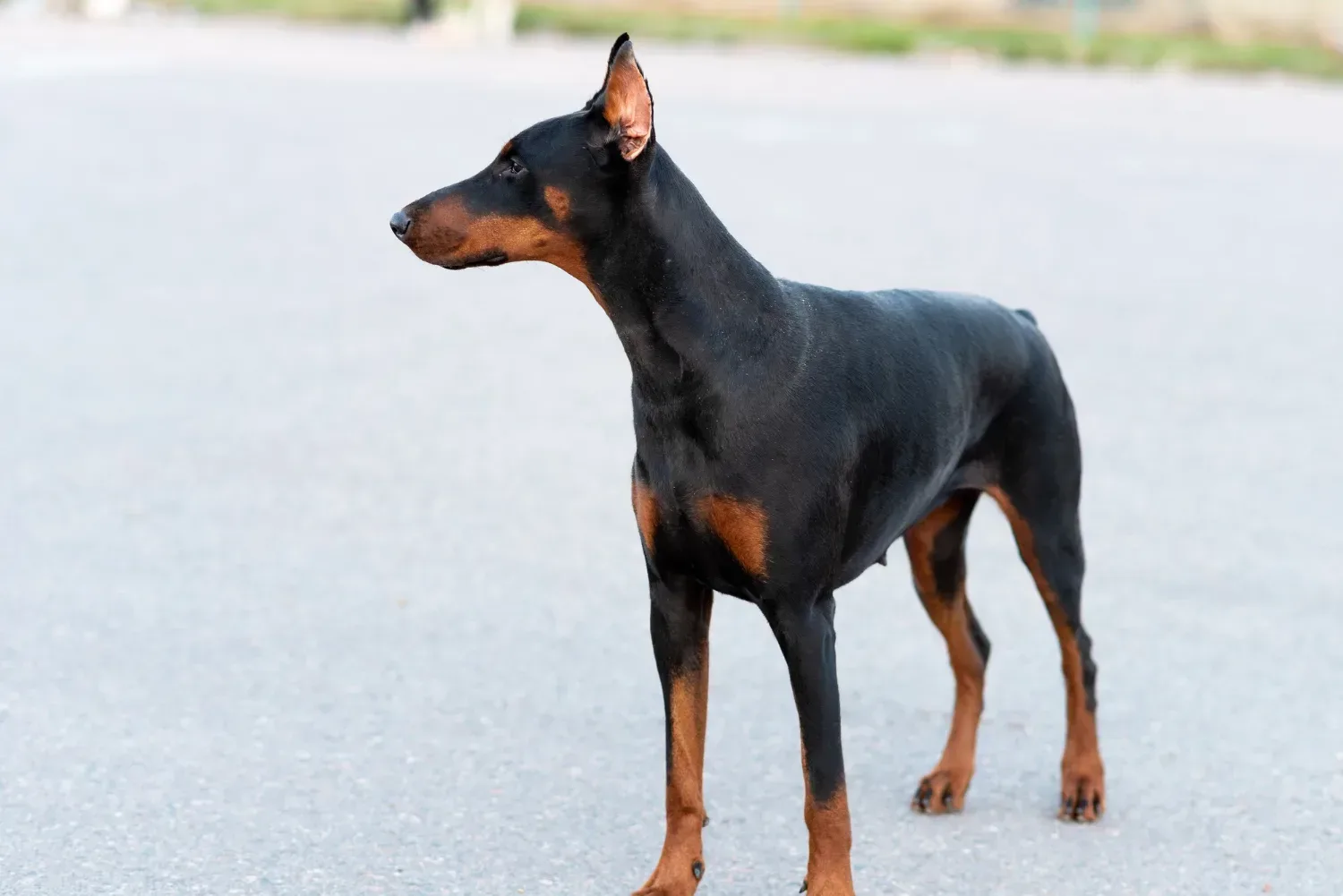
All about german pinscher – dog breed
If you are interested in learning more about the German pinscher, this article is for you. This article will provide you with a basic understanding of this dog breed, its characteristics, health, and training. The following are some of the common questions about the German pinscher. Hopefully, this information will help you decide whether a pinscher is right for your family. We will also discuss some of the challenges this breed can present.
German pinscher
The German pinscher – a breed of dog known for its bold personality – requires proper training in order to be a well-mannered pet. Early training is essential for this breed as it helps establish you as the pack leader. However, you should not intimidate your pet by using harsh training methods because it will create a rift between you and your dog. A German pinscher – dog breed with proper training habits can impress anyone.
The German pinscher is a medium-sized dog that stands 17 to 20 inches high. Its long, solid legs are equal to its height. Their short, dense coat requires minimal maintenance other than weekly brushing and bathing. German pinschers shed moderately and can be quite energetic. They are an excellent companion for anyone who enjoys a good game of fetch! However, beware of German pinscher puppies.
The German pinscher is an extremely intelligent breed that thrives on socialization. They can take part in advanced obedience classes and agility events. Getting out and socializing with other people and pets is recommended as this breed is naturally alert and aggressive. As a result, you should spend a considerable amount of time socializing your dog during its early years. By socializing your pup early on, you can prevent your dog from becoming aggressive towards other animals.
A German pinscher is a medium-sized working dog with a smooth, short coat. Its high energy level and sensitivity to training makes this dog an excellent choice for guarding and working. While they do need plenty of exercise, this breed makes a wonderful companion for a family or active lifestyle. It needs to be kept out of the elements, but is generally playful and affectionate with its owner. They can also be very watchful around strangers and don’t like being locked up.
Because they are intelligent and very loving, a German pinscher is an ideal family pet. It is excellent with children, but can be jumpy around younger children. Although German pinschers get along well with other dogs, they need to be socialized with children from a young age. This breed does not do well with cats and can be a challenging dog to train. It needs daily exercise and mental stimulation to keep happy and healthy.
German pinscher characteristics
Among the many German pinscher characteristics are their beautiful eyes and sharp intelligence. They are easy to train and require minimal socialization, but they are prone to becoming stubborn and domineering. Like all dogs, they require mental stimulation to prevent destructive behavior. German pinschers should be sheltered from cold weather, as they are susceptible to certain conditions. Hip dysplasia (a malformation of the hip joint) can cause pain and lameness. Another condition, progressive retinal degeneration, causes the nerve cells in the back of the eye to die. In severe cases, the condition can cause blindness.
In addition to their temperament, German pinschers are excellent guard dogs. They exhibit strong guarding instincts and are sight and sound-oriented. While their protective nature makes them a good choice for families with older children, they can become too boisterous and jumpy if housed with very young children. German pinschers may not get along with other dogs and strangers unless properly socialized during their development period. They also require a lot of attention and exercise.
Another German pinscher characteristic is its head shape. Medium-sized German pinschers do not grow large, but they are well-muscled and have a “V”-shaped head with dark eyes. Once, the ears were trimmed but German pinscher laws banned this practice in 1987. The ears are black, and their tips are slightly drooping. However, they do not require regular grooming. A medium German pinscher weighs anywhere from twenty to forty-five pounds.
The German Pinscher is a medium-sized dog that stands between 17 to 20 inches at the shoulder. Their coat is short and close-lying, and it can be very hard to touch. Colors range from brown to black, and some breeds have blue or red tinges. A red German pinscher will have black hairs. It is a sturdy, intelligent dog with powerful guarding instincts. This medium-sized breed is also known for its strong hunting instincts.
A German Pinscher is a lively property guard. It barks to alert its owners of intruders. The German Pinscher is highly intelligent and a good watchdog, but it can be wary of strangers. If left alone for too long, this dog may become mischievous and obnoxious, so be sure to give it plenty of time. It needs constant praise and motivation to succeed in obedience. It should not be left alone at home. It is best suited for an active family with no young children.
German pinscher health
Keeping your German pinscher healthy is a top priority for your German pinscher’s wellbeing. In addition to regular vet visits, you should make sure that your dog is getting enough exercise, ensuring that it gets plenty of playtime and giving preventative medications for parasites. In terms of weight, German pinschers should weigh between 25 and 45 pounds. While they have a tendency to put on weight, you can help your pet stay slim by limiting their food intake and counting their treats in their overall daily caloric intake.
The most common cause of death among German Pinschers during their golden years is heart failure. In dogs, heart valve disease usually stems from the weakening of a heart valve, which allows blood to leak back around the valve and strain it. Your pet may not show any symptoms of heart valve disease, but you can find out if there is a murmur in the dog’s heart. A doctor can also perform a heart valve test to determine the severity of the condition. This test must be repeated annually, and you should always get your dog checked for heart health during its golden years.
Keeping your German pinscher healthy is also a matter of socialization. Early socialization is important as this breed can be suspicious of new people and other animals. Early socialization and training can help prevent unwanted behavior and aggression. However, you should always remember that the German pinscher was bred to hunt vermin, and as such, it does not get along with other dogs and small animals. During training, be sure not to intimidate or use harsh methods, as this will only lead to a rift between you and your dog.
A daily walk or long hike with a fenced area are ideal for your German pinscher. In addition to walking, exercise can be as simple as a vigorous game of fetch. Besides long walks, your German pinscher will also enjoy running alongside your bicycle or jogging. In addition, German pinschers shed in seasonal cycles, so it is important to brush and groom their coats regularly. And make sure to brush their ears and nails every week.
German pinscher training
During German pinscher training, owners should be patient. If the dog messes in the house, owners should remove them immediately to the designated outside spot. If the dog poos outside, the owner should praise them and reward them. When the dog eliminates successfully, it will be more likely to continue training. However, if it poos in the house more frequently, the owner should increase the amount of time between the messes.
Although German Pinschers aren’t known for their excessive barking, they are prone to chewing objects and jumping up on people. Similarly, they are great at destroying plush and squeaky toys. Lack of exercise or daily mental stimulation can lead to destructive behavior, especially if the dog is not given sufficient exercise. Fortunately, these dogs are easily trained if given the proper exercise and management. Nevertheless, despite their adorable appearance, these dogs need daily exercise.
While German Pinschers are great with kids, they can be domineering. To make sure that your pup won’t attack a child, introduce them to your children when they’re young. Children aren’t a danger to German Pinschers, but they should be taught how to interact with them. It’s important to be patient as this breed can be dominant and dominate. But be patient with them! A great training session will make your dog even more adorable!
While German pinschers are generally gentle and affectionate, they are also high-energy and can be aggressive. Because of their guarding nature, they may not be suitable for families with young children. Moreover, these dogs may not get along with other animals or strangers without proper socialization. This is another reason for putting in effort and time for German pinscher training. If you can commit to these basic steps, German pinscher training will be a breeze.
The German pinscher is a medium-sized dog with strong coat and muscular body. They are available in three color varieties: red fawn, black & tan, and dark brown with yellow markings. Their ears are large and alert, and they have a natural fold if not cropped. Their medium-sized black nose is also prominent. The back of their neck is erect. Their tail is docked.

